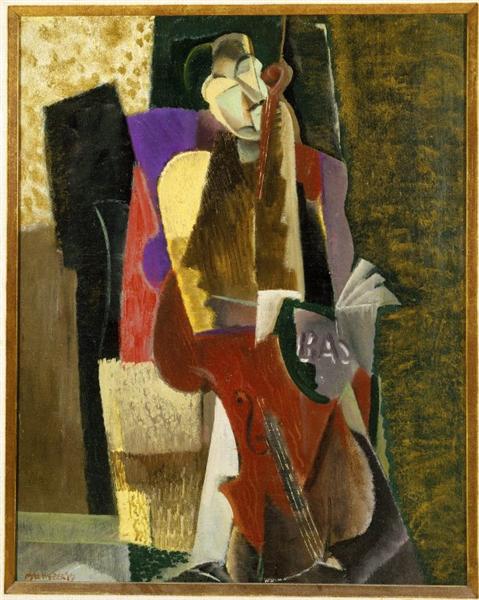Cello Suite no 5 in C minor – J.S. Bach

“The Cellist“ (c.1917)
______
what struck me immediately upon hearing
the bow’s very first strokes on the violin in
this Fifth Cello Suite of Bach was that the
mood was not only brashly Romantic, but
quite specifically Russian Romantic, right
up there with Dostoyevsky, and “Fiddler
on the Roof“, dark brooding colours at
first, followed by long plaintive musical
phrases, you can even hear the sound of
the steppes, I thought, stretching out into
the endless distance, this performance,
I surmised, is not, other than
compositionally, Baroque, not to mention
not even German
yet as played by Mischa Maisky, it’s one
of the best versions of the Fifth I’ve ever
heard, and if it works, who’s to complain
but more context – Bach never gave not
only textural indications, but not even
tempos to his pieces, apart from the
very dance terms that identify the
movements, so what, therefore, is the
specific pace, you’ll ask, of a courante,
for instance, you tell me, I’ll reply
in other words, the modular terms were
significantly looser in the early 18th
Century than later, when metronome
markings would begin to demand more
accurate replication of the artist’s
explicit specifications – Beethoven
especially made sure of that, by
requiring accurate renderings of his
mood or pace indications, largo,
allegro, andante, for instance, still less
strict than the stipulation later for exact
musical beats per minute – trying to
keep pace with a prerecorded tape, for
example, as in again the industrially
driven, which is to say emotionally
indifferent, context of the seismic
“Different Trains“, a masterpiece of a
more technically conditioned era
I don’t think that Bach would at all have
been disappointed that the heirs of his
fervent, though more genteel, creations
might’ve morphed into something
profound for other groups, be they
national, or of a class, or of even a
generation, of people, which is to say
that these works have superseded
their merely regional intent, and have
reached beyond space and time, the
very purview of music, to speak a
common and cooperative, indeed a
binding, language
I said to my mom the other day that if
we all sang together, we could save
the world
R ! chard
psst: Maisky’s encore,, incidentally, is from
the “Bourrée” of Bach’s Third Cello
Suite, note this contrasting, more
courtly – more refinement, more
reserve – rendition, you can even
hear, not to mention see, in this
particular instance, not Russian
steppes, but European trees on
their baronial estates, if you lend
an attentive ear








